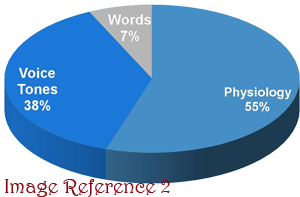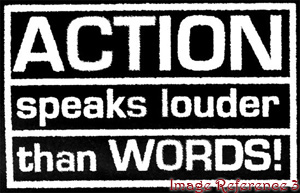Non-Verbal Communication
What is Non-Verbal Communication? Why is it important?

Non-verbal communication is all the things that communicate something to someone except for the direct words being used. This can be both unintentional and intentional and typically includes, but is not limited to, touch, eye contact, volume, proximity, gestures, intonation, posture, sounds (paralanguage), facial expressions, and vocal nuance (Andrews University, 2012).

These cues help us to convey or understand information about emotional state, reinforce/modify what the words are saying, provide feedback, regulate the flow of conversation, and to define or reinforce a relationship between people (SkillsYouNeed, 2012). Tests have proven that people tend to assume that the information they receive from non-verbal communication is more truthful that what the verbal message (International Assocation of Conference Interpreters, 2012). When the non-verbal cues match the verbal message, it tends to increase trust, clarity, and rapport while a mismatching communication tends to breed tension, mistrust, and confusion (Segal, Smith, & Jaffe, 2012).
Types of Non-Verbal Cues
Reading Those Non-Verbal Cues
Being aware of these cues contributes to what is commonly referred to as Emotional Intelligence and being able to read non-verbal communication will help you in all your interpersonal relationships. There are several ways to increase your ability to read non-verbal cues. You need to pay attention to any inconsistencies between the verbal message and the non-verbal communication. It's also important to consider the nonverbal signals as a whole group and not just individual cues. You will get a more accurate reading if you consider the whole of behaviour. It's also important to trust your instincts (Cherry, 2012). Lastly, you can consider the following questions

- What kind of eye contact is being made? Is it just right? Too intense? Avoiding?
- What kind of facial expressions are you seeing? Are they showing emotion in their expressions?
- What tone of voice are they projecting?
- Are their shoulders raised and tense? Sloped?
- Are they appearing relaxed?
- Is there any physical contact? Is it appropriate?
- How is the flow of the conversation? Easy paced? Strained?
These are just some starting considerations and as you begin to pay closer attention you will notice more and develop your ability to communicate (Cherry, 2012).
Using Non-Verbal Cues to Help Direct Conversation
When engaged in a difficult or emotionally charged conversation, you can take steps to help reduce the tension by using your knowledge of non-verbal cues. The first step is to control your own stress. Try to regulate your breathing, keep your voice in a nice steady tone and level. Sit comfortably and try to remain as relaxed as possible. Simply by controlling your own non-verbal cues, for many situations, you can de-escalate an emotionally charged conversation.
When someone is upset and pacing, they will get more upset as their physical tension rises. By controlling your own reactions and non-verbal cues, you are being a good model and also failing to feed the momentum or their negative emotions. If someone is yelling and you keep your voice steady and even, it will draw more of their attention to their outburst and they will calm to come closer to your demeanour.
The other way you can work to de-escalate an emotionally charged conversation with your body language is to try to retain your calm while you simply remain silent. People will get angry when they feel they are not being listened to. If your words are not having an effect, simply let them talk and they will begin to settle down once they feel they have had the chance to have their say and they notice your calm and relaxed demeanour. This will not work for every situation, as in some situations the other person may feel that their emotional release is being greeted with apathy, and it will definitely not be easy.
As with all things, practice makes perfect!
Recommended Reading
These books have been read and reviewed by Keeping it Kinky and we recommend them as resources in the area of communication
Article References
Andrews University. (2012). Non-Verbal Communication Modes. Retrieved 11 23, 2012, from Intercultural Business Relations: http://www.andrews.edu/~tidwell/bsad560/NonVerbal.html
Cherry, K. (2012). Types of Nonverbal Communication. Retrieved 11 23, 2012, from About.com Psychology: http://psychology.about.com/od/nonverbalcommunication/a/nonverbaltypes.htm
International Assocation of Conference Interpreters. (2012). The Importance of non-verbal communication in professional interpretation. Retrieved 11 23, 2012, from Aiic: http://aiic.net/page/1662
Segal, J., Smith, M., & Jaffe, J. (2012, 09). Nonverbal Communication: Improving your nonverbal skills and reading body language. Retrieved 11 23, 2012, from HelpGuide: http://www.helpguide.org/mental/eq6_nonverbal_communication.htm
SkillsYouNeed. (2012). Non-Verbal Communication. Retrieved 11 23, 2012, from Skills You Need: Helping you Develop Life Skills: http://www.skillsyouneed.co.uk/IPS/NonVerbal_Communication.html
Image References
Someone else's art deserves recognition! The images presented in this article were borrowed from the following places:
Header Image: http://freezapnuggets.com/wordpress/wp-content/uploads/2013/03/freenuggets_nonverbal_comm01_425.png | Retrieved April 25, 2015
Image 1: http://biginterview.com/blog/wp-content/uploads/2010/03/mime.jpg | Retrieved November 23, 2012
Image 2: http://www.maximumadvantage.com/images/Components%20of%20Communication.jpg | Retrieved November 23, 2012
Image 3: http://3.bp.blogspot.com/_c4yBs2BGFyY/TF7Aq593nWI/AAAAAAAAACI/jC6RQgwRTGQ/s1600/action_speaks-louder-than-words1.jpg | Retrieved November 23, 2012

